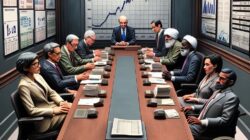November Job Growth: A Closer Look at Economic Implications
In a striking display of economic resilience, employers across the nation added a remarkable 227,000 new jobs in November. This significant surge has not only highlighted the strength of the labor market but has also reignited discussions surrounding potential future interest rate decisions by the Federal Reserve. With markets and analysts closely monitoring these developments, the broader economic outlook is at the forefront of their considerations.
The Labor Market’s Resilience
November’s robust job creation figures come at a crucial juncture, suggesting that the economy is navigating through various challenges with relative ease. Economists had predicted a more modest gain, underscoring the unexpected nature of the reported numbers. The diverse sectors contributing to this growth indicate a broad-based demand for labor—an encouraging sign after months of fluctuating employment rates.
According to the U.S. Bureau of Labor Statistics, sectors such as healthcare, leisure and hospitality, and professional services were among the leading contributors to job creation this past month. The healthcare sector alone saw significant hiring, reflecting ongoing demands in response to an aging population and emerging health needs. Meanwhile, the leisure and hospitality industries continue to rebound as consumer confidence rises, demonstrating a strong willingness to engage in activities that were previously curtailed due to the pandemic.
Implications for Future Interest Rates
As job growth serves as a critical barometer of economic health, the latest employment figures have significant implications for monetary policy, particularly decisions regarding interest rates. The Federal Reserve, which continuously assesses economic indicators to inform its policy decisions, may view this surge in job creation as evidence of sustained economic momentum.
When the labor market is strong, inflationary pressures often accompany it, as increased employment typically leads to higher wages and subsequently greater consumer spending. This sequence of events can inspire the Fed to consider raising interest rates to keep inflation in check. Thus, the job growth seen in November may prompt conversations among Federal Reserve officials about adjusting their stance on interest rates sooner rather than later.
Market Reactions: What Investors Are Watching
Financial markets, ever-sensitive to economic indicators, are closely scrutinizing the implications of November’s job creation figures. Investors are looking for signals that could determine the Fed’s next moves regarding monetary policy. Stocks and bonds are reacting to the possibility of tighter monetary measures, with analysts projecting various scenarios based on economic fundamentals.
For instance, a strong labor market may lead to a consensus among investors that the Fed will increase interest rates in the coming months to alleviate inflation pressures. Conversely, ongoing uncertainty in other economic indicators—such as inflation rates, wage growth, and consumer spending—may temper such predictions.
The Broader Economic Outlook
The impact of job growth extends beyond immediate interest rate considerations. A thriving labor market not only enhances consumer confidence but also fosters business investment. As companies expand their workforce, they are more likely to invest in infrastructure, technology, and other resources that contribute to long-term economic growth.
However, it is essential to acknowledge potential challenges lurking on the horizon. Supply chain disruptions, inflationary pressures stemming from geopolitical tensions, and uncertainties in global markets could offset the positive effects of job creation. The interplay between domestic labor dynamics and international economic conditions will play a pivotal role in shaping the trajectory of the U.S. economy moving forward.
Future Economic Prospects: What Lies Ahead
This positive employment report raises pertinent questions about the economic outlook for the upcoming months. While the November job figures are promising, sustaining such growth will require continued collaboration between businesses, policymakers, and workers.
As the country moves into the new year, the Federal Reserve will likely remain in a reactive mode, adjusting its policies in response to evolving economic conditions. Key metrics to watch will include wage growth, consumer sentiment, and inflation rates, which will all intersect to inform the Fed’s decision-making process.
Conclusion
The creation of 227,000 new jobs in November is more than just a statistical achievement; it is a signal of resilience and potential strength in the U.S. economy. Markets are keenly attuned to this development, recognizing that the implications for interest rates could be substantial. As we look ahead, the persistence of job growth will play a crucial role in shaping the broader economic landscape and influencing key policy decisions that could affect every American.












